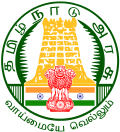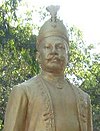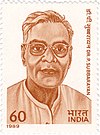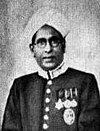List of chief ministers of Tamil Nadu
| Chief Minister of Tamil Nadu | |
|---|---|
| Tamiḻnāṭu Muthalamaichar | |
 | |
| Style | The Honourable (Formal) Mr./Mrs. Chief Minister (Informal) |
| Type | Head of Government |
| Status | Leader of the Executive |
| Abbreviation | CMOTN |
| Member of | |
| Reports to | |
| Residence | 25/9, Chittaranjan Salai, Cenotaph 2nd Lane, Alwarpettai, Chennai – 600018, Tamil Nadu, India. |
| Seat | Office of Chief Minister of Tamil Nadu, Fort St. George, Chennai – 600009, Tamil Nadu, India. |
| Appointer | Governor of Tamil Nadu by convention based on appointees ability to command confidence in the Tamil Nadu Legislative Assembly |
| Term length | At the pleasure of the governor Legislative Assembly term 5 years unless dissolved sooner no term limits specified |
| Formation | 10 April 1952 |
| First holder |
|
| Deputy | Deputy Chief Minister of Tamil Nadu |
| Website | www |
The Chief Minister of Tamil Nadu is the chief executive of the Indian state of Tamil Nadu. In accordance with the Constitution of India, the governor is a state's de jure head, but de facto executive authority rests with the chief minister. Following elections to the Tamil Nadu Legislative Assembly, the state's governor usually invites the party (or coalition) with a majority of seats to form the government. The governor appoints the chief minister, whose council of ministers are collectively responsible to the assembly. Given that he has the confidence of the assembly, the chief minister's term is for five years and is subject to no term limits.[2]
Since 1952, Tamil Nadu has had 12 chief ministers, 13 including V. R. Nedunchezhiyan, who twice acted in the role. The longest-serving chief minister, M. Karunanidhi from Dravida Munnetra Kazhagam held the office for over eighteen years in multiple tenures, while he was the one who had the largest gap between two terms (nearly thirteen years). The All India Anna Dravida Munnetra Kazhagam's former general secretary J. Jayalalithaa has the second-longest tenure, and its founder M. G. Ramachandran, the first actor to become the chief minister in India has the third-longest tenure, while his wife V. N. Janaki Ramachandran has the shortest tenure (only 23 days). K. Kamaraj resigned his post of his own free will and devoted all of his energy to the revitalization of the Indian National Congress party; he was responsible for the elevation of Lal Bahadur Shastri to the position of Prime Minister of the Republic of India following the death of Jawaharlal Nehru and of Indira Gandhi following the death of Lal Bahadur Shastri. C. Rajagopalachari served as the last Governor-General of the Union of India before becoming chief minister of undivided Madras State. There have been four instances of president's rule in Tamil Nadu, most recently in 1991.[3][4]
The current incumbent is M. K. Stalin of the Dravida Munnetra Kazhagam since 7 May 2021.
List of chief ministers
The Madras Presidency, headquartered in Fort St. George, India, was a province of British India that comprised present day Tamil Nadu, the Malabar region of North Kerala, the coastal and Rayalaseema regions of Andhra Pradesh, and the Bellary, Dakshina Kannada, and Udupi districts of Karnataka. It was established in 1653 to be the headquarters of the English settlements on the Coromandel Coast.
The territory under the presidency comprised only Madrasapattinam and its surrounding regions. But, after the Anglo-French wars and the consequent alliance between the English East India Company and the Nawab of Arcot, it was expanded to comprise the region from the Northern Circars to Cape Comorin. The governance structure also evolved from a modest secretariat with a single secretary for the Public Department in 1670 to six departments overseen by a chief secretary by 1920.
The Indian Councils Act 1861 set up the Madras Legislative Council as an advisory body, without powers, through which the colonial administration obtained advice and assistance from able and willing Indian business leaders. But membership was selected (not elected) and was not representative of the masses.
With the enactment of the Government of India Act 1919, the first legislature was formed in 1920 after general elections.[5] The term of the legislative council was three years. It had 132 members, of whom 34 were nominated by the governor and the rest were elected. Under the Government of India Act 1935, a bicameral legislature was set up with a legislative assembly consisting of 215 members and a legislative council having 56 members. The first legislative assembly under this act was constituted in July 1937. The legislative council was a permanent body, with a third of its members retiring every 3 years and having the power to decide on bills passed by the assembly.[6]
In 1939, the British government declared India's entrance into World War II without consulting provincial governments. The Indian National Congress protested by asking all its elected representatives to resign from governments.[7] Congress came back to power in 1946 after new provincial elections.[8]
Chief Secretariat of Tamil Nadu
|
|
| Chief Ministers of Madras Presidency | |||||||||||
|---|---|---|---|---|---|---|---|---|---|---|---|
| No. | Portrait | Name
(Birth–Death) |
Elected Constituency | Term of office[10] | Council (Election) |
Ministry | Appointed by | Political Party[a] | |||
| Assumed Office | Left Office | Time in Office | |||||||||
| 1 | 
|
A. Subbarayalu Reddiar (1855–1921) |
Leader of the Presidency Legislative Council | 17 December 1920 | 11 July 1921[RES] | 206 days | 1st (1920 election) |
Reddiar | Frederic Thesiger | South Indian Liberal Federation | |
| 2 | 
|
Panaganti Ramarayaningar (1866–1928) |
Leader of the Presidency Legislative Council | 11 July 1921 | 11 September 1923 | 5 years, 145 days | Ramarayaningar I | Rufus Isaacs | |||
| 12 September 1923 | 3 December 1926 | 2nd (1923 election) |
Ramarayaningar II | ||||||||
| 3 | 
|
P. Subbarayan (1889–1962) |
Leader of the Presidency Legislative Council | 4 December 1926 | 27 October 1930 | 3 years, 327 days | 3rd (1926 election) |
Subbarayan | Edward Wood | Independent | |
| 4 | 
|
B. Munuswamy Naidu (1885–1935) |
Leader of the Presidency Legislative Council | 27 October 1930 | 4 November 1932[RES] | 2 years, 8 days | 4th (1930 election) |
Naidu | South Indian Liberal Federation | ||
| 5 | Ramakrishna Ranga Rao (1901–1978) |
Leader of the Presidency Legislative Council | 5 November 1932 | 5 November 1934 | 3 years, 151 days | Rao I | Freeman Freeman-Thomas | ||||
| 5 November 1934 | 4 April 1936[RES] | 5th (1934 election) |
Rao II | ||||||||
| 6 | 
|
P. T. Rajan (1892–1974) |
Leader of the Presidency Legislative Council | 4 April 1936 | 24 August 1936[RES] | 142 days | Rajan | ||||
| (5) | Ramakrishna Ranga Rao (1901–1978) |
Leader of the Presidency Legislative Council | 24 August 1936[§] | 1 April 1937 | 220 days | Rao III | Victor Hope | ||||
| 7 | 
|
Kurma Venkata Reddy Naidu (1875–1942) |
Leader of the Presidency Legislative Council | 1 April 1937 | 14 July 1937[RES] | 104 days | 1st (1937 election) |
Naidu | Independent | ||
| 8 | 
|
C. Rajagopalachari (1878–1972) |
Leader of the Presidency Legislative Council | 14 July 1937 | 29 October 1939[RES] | 2 years, 107 days | Rajagopalachari I | Indian National Congress | |||
| – | 
|
Vacant (Governor-General's rule) |
N/A | 29 October 1939 | 29 April 1946 | 6 years, 182 days | Dissolved | N/A | – | N/A | |
| 9 | 
|
T. Prakasam (1872–1957) |
Leader of the Presidency Legislative Council | 30 April 1946 | 23 March 1947[RES] | 327 days | 2nd (1946 election) |
Prakasam | Archibald Wavell | Indian National Congress | |
| 10 | 
|
Omanthur P. Ramaswamy Reddiar (1895–1970) |
Leader of the Presidency Legislative Council | 23 March 1947 | 6 April 1949[RES] | 2 years, 14 days | Reddiar | Archibald Nye | |||
| 11 | 
|
P. S. Kumaraswamy Raja (1898–1957) |
Leader of the Presidency Legislative Council | 6 April 1949 | 25 January 1950 | 294 days | Raja | Krishna Kumarsinhji Bhavsinhji | |||
- Timeline

- Development after independence
Madras State, the precursor to the present-day state of Tamil Nadu, was created after India became a republic on 26 January 1950.[11] It comprised present-day Tamil Nadu and parts of present-day Andhra Pradesh, Karnataka, and Kerala. The first legislature of the Madras State to be elected on the basis of universal suffrage was constituted on 1 March 1952, after the general elections held in January 1952.[12]
The state was split up along linguistic lines in 1953, carving out Andhra State. Under the States Reorganisation Act, 1956, the states of Kerala, and Mysore State were carved out of Madras State. Under the Andhra Pradesh and Madras Alteration of Boundaries Act, 1959, with effect from 1 April 1960, Tiruttani taluk and Pallipattu sub-taluk of Chittoor district of Andhra Pradesh were transferred to Madras in exchange for territories from the Chingelput and Salem districts.[5][13]
|
|
| Chief Ministers of Madras State | |||||||||||
|---|---|---|---|---|---|---|---|---|---|---|---|
| No. | Portrait | Name
(Birth–Death) |
Elected Constituency | Term of office[10] | Assembly (Election) |
Ministry | Appointed by | Political Party[a] | |||
| Assumed Office | Left Office | Time in Office | |||||||||
| 1 | 
|
P. S. Kumaraswamy Raja (1898–1957) |
Leader of the State Legislative Council | 26 January 1950 | 9 April 1952 | 2 years, 74 days | 2nd (1946 election) |
Raja | Krishna Kumarsinhji Bhavsinhji | Indian National Congress | |
| 2 | 
|
C. Rajagopalachari (1878–1972) |
Leader of the State Legislative Council | 10 April 1952 | 13 April 1954[RES] | 2 years, 3 days | 1st (1952 election) |
Rajagopalachari II | Sri Prakasa | ||
| 3 | 
|
K. Kamaraj (1903–1975) |
Gudiyatham | 13 April 1954 | 12 April 1957 | 9 years, 172 days | Kamaraj I | ||||
| Sattur | 13 April 1957 | 14 March 1962 | 2nd (1957 election) |
Kamaraj II | A. J. John | ||||||
| 15 March 1962 | 2 October 1963[RES] | 3rd (1962 election) |
Kamaraj III | Bishnu Ram Medhi | |||||||
| 4 | 
|
M. Bhakthavatsalam (1897–1987) |
Sriperumbudur | 2 October 1963 | 5 March 1967 | 3 years, 154 days | Bhakthavatsalam | ||||
| 5 | 
|
C. N. Annadurai (1909–1969) |
Leader of the State Legislative Council | 6 March 1967 | 13 January 1969 | 1 year, 313 days | 4th (1967 election) |
Annadurai | Ujjal Singh | Dravida Munnetra Kazhagam | |
- Change in nomenclature
During the term of the fourth assembly on 18 July 1967, the house unanimously adopted and recommended that steps be taken by the state government to secure the necessary amendment to the Constitution of India to change the name of Madras State to Tamil Nadu. Accordingly, the Madras State (Alteration of Name) Act, 1968 (Central Act 53 of 1968) was passed by the Parliament of India and came into force on 14 January 1969.[14] Consequently, the nomenclature "Madras Legislative Assembly" was changed to "Tamil Nadu Legislative Assembly". From 1967 onward, the strength of the assembly continued to remain at 234 plus a nominated member.
From 1952 to 1986, the state had a parliamentary system of government with two democratically elected houses, the Legislative Assembly and the Legislative Council. On 14 May 1986, the state government passed a resolution to abolish the legislative council in the state, which was then moved and adopted by the house. On 1 November 1986, Tamil Nadu became a state with a unicameral legislature, and since then, several times, the state government has taken steps to reconstitute the legislative council, but they have failed for so long. The Tamil Nadu Legislative Council has not been constituted in the state till date.
|
|
| Chief Ministers of Tamil Nadu | |||||||||||
|---|---|---|---|---|---|---|---|---|---|---|---|
| No. | Portrait | Name
(Birth–Death) |
Elected Constituency | Term of office[10] | Assembly (Election) |
Ministry | Appointed by | Political Party[a] | |||
| Assumed Office | Left Office | Time in Office | |||||||||
| 1 | 
|
C. N. Annadurai (1909–1969) |
Leader of the State Legislative Council | 14 January 1969 | 3 February 1969[†] | 20 days | 4th (1967 election) |
Annadurai | Ujjal Singh | Dravida Munnetra Kazhagam | |
| Acting | 
|
V. R. Nedunchezhiyan (1920–2000) |
Triplicane | 3 February 1969 | 10 February 1969[RES] | 7 days | Nedunchezhiyan I | ||||
| 2 | 
|
M. Karunanidhi (1924–2018) |
Saidapet | 10 February 1969 | 14 March 1971 | 6 years, 355 days | Karunanidhi I | ||||
| 15 March 1971 | 31 January 1976 | 5th (1971 election) |
Karunanidhi II | ||||||||
| – | 
|
Vacant (President's rule) |
N/A | 31 January 1976 | 29 June 1977 | 1 year, 149 days | Dissolved | N/A | – | N/A | |
| 3 | 
|
M. G. Ramachandran (1917–1987) |
Aruppukottai | 30 June 1977 | 17 February 1980 | 2 years, 232 days | 6th (1977 election) |
Ramachandran I | Prabhudas B. Patwari | All India Anna Dravida Munnetra Kazhagam | |
| – | 
|
Vacant (President's rule) |
N/A | 17 February 1980 | 8 June 1980 | 112 days | Dissolved | N/A | – | N/A | |
| (3) | 
|
M. G. Ramachandran (1917–1987) |
Madurai West | 9 June 1980[§] | 9 February 1985 | 7 years, 198 days | 7th (1980 election) |
Ramachandran II | Prabhudas B. Patwari | All India Anna Dravida Munnetra Kazhagam | |
| Andipatti | 10 February 1985 | 24 December 1987[†] | 8th (1984 election) |
Ramachandran III | S. L. Khurana | ||||||
| Acting | 
|
V. R. Nedunchezhiyan (1920–2000) |
Athoor | 24 December 1987 | 7 January 1988[RES] | 14 days | Nedunchezhiyan II | ||||
| 4 | 
|
V. N. Janaki Ramachandran (1924–1996) |
Did not contest | 7 January 1988 | 30 January 1988 | 23 days | Janaki | ||||
| – | 
|
Vacant (President's rule) |
N/A | 30 January 1988 | 26 January 1989 | 362 days | Dissolved | N/A | – | N/A | |
| (2) | 
|
M. Karunanidhi (1924–2018) |
Harbour | 27 January 1989[§] | 30 January 1991 | 2 years, 3 days | 9th (1989 election) |
Karunanidhi III | P. C. Alexander | Dravida Munnetra Kazhagam | |
| – | 
|
Vacant (President's rule) |
N/A | 30 January 1991 | 23 June 1991 | 144 days | Dissolved | N/A | – | N/A | |
| 5 | 
|
J. Jayalalithaa (1948–2016) |
Bargur | 24 June 1991 | 12 May 1996 | 4 years, 323 days | 10th (1991 election) |
Jayalalithaa I | Bhishma Narain Singh | All India Anna Dravida Munnetra Kazhagam | |
| (2) | 
|
M. Karunanidhi (1924–2018) |
Chepauk | 13 May 1996[§] | 13 May 2001 | 5 years | 11th (1996 election) |
Karunanidhi IV | Marri Chenna Reddy | Dravida Munnetra Kazhagam | |
| (5) | 
|
J. Jayalalithaa (1948–2016) |
Did not contest | 14 May 2001[§] | 21 September 2001[RES] | 130 days | 12th (2001 election) |
Jayalalithaa II | Fathima Beevi | All India Anna Dravida Munnetra Kazhagam | |
| 6 | 
|
O. Panneerselvam (1951–) |
Periyakulam | 21 September 2001 | 2 March 2002[RES] | 162 days | Panneerselvam I | C. Rangarajan | |||
| (5) | 
|
J. Jayalalithaa (1948–2016) |
Andipatti | 2 March 2002[§] | 12 May 2006 | 4 years, 71 days | Jayalalithaa III | P. S. Ramamohan Rao | |||
| (2) | 
|
M. Karunanidhi (1924–2018) |
Chepauk | 13 May 2006[§] | 15 May 2011 | 5 years, 2 days | 13th (2006 election) |
Karunanidhi V | Surjit Singh Barnala | Dravida Munnetra Kazhagam | |
| (5) | 
|
J. Jayalalithaa (1948–2016) |
Srirangam | 16 May 2011[§] | 27 September 2014 | 3 years, 134 days | 14th (2011 election) |
Jayalalithaa IV | All India Anna Dravida Munnetra Kazhagam | ||
| (6) | 
|
O. Panneerselvam (1951–) |
Bodinayakanur | 28 September 2014[§] | 23 May 2015[RES] | 237 days | Panneerselvam II | Konijeti Rosaiah | |||
| (5) | 
|
J. Jayalalithaa (1948–2016) |
Dr. Radhakrishnan Nagar | 23 May 2015[§] | 22 May 2016 | 1 year, 196 days | Jayalalithaa V | ||||
| 23 May 2016 | 5 December 2016[†] | 15th (2016 election) |
Jayalalithaa VI | ||||||||
| (6) | 
|
O. Panneerselvam (1951–) |
Bodinayakanur | 5 December 2016[§] | 15 February 2017[RES] | 72 days | Panneerselvam III | C. Vidyasagar Rao | |||
| 7 | File:EdappadiKPalaniswami.jpg | Edappadi K. Palaniswami (1954–) |
Edappadi | 16 February 2017 | 6 May 2021 | 4 years, 79 days | Palaniswami | ||||
| 8 | 
|
M. K. Stalin (1953–) |
Kolathur | 7 May 2021 | Incumbent | 3 years, 22 days | 16th (2021 election) |
Stalin | Banwarilal Purohit | Dravida Munnetra Kazhagam | |
Timeline

- List by party
| No. | Political party | Number of Chief ministers | Total days of holding CMO |
|---|---|---|---|
| 1 | All India Anna Dravida Munnetra Kazhagam | 5+1 acting | 11004 days |
| 2 | Dravida Munnetra Kazhagam | 3+1 acting | 8758 days |
| 3 | Indian National Congress | 4 | 6247 days |
- Parties by total duration (in days) of holding Chief Minister's Office

See also
- History of Tamil Nadu
- Elections in Tamil Nadu
- List of governors of Tamil Nadu
- Chief Secretariat of Tamil Nadu
- Tamil Nadu Legislative Assembly
- List of current Indian chief ministers
- List of deputy chief ministers of Tamil Nadu
- List of speakers of the Tamil Nadu Legislative Assembly
- List of leaders of the house in the Tamil Nadu Legislative Assembly
- List of leaders of the opposition in the Tamil Nadu Legislative Assembly
Notes
References
- ^ "Chief Ministers of Tamil Nadu since 1920". Tamil Nadu Legislative Assembly. Retrieved 3 August 2021.
- ^ Durga Das Basu. Introduction to the Constitution of India. 1960. 20th Edition, 2011 Reprint. pp. 241, 245. LexisNexis Butterworths Wadhwa Nagpur. ISBN 978-81-8038-559-9. Note: although the text talks about Indian state governments in general, it applies for the specific case of Tamil Nadu as well.
- ^ Archive.org — Government of Tamil Nadu — Chief Ministers of Tamil Nadu since 1920
- ^ Government of Tamil Nadu — Assemblies — An Overview Archived 6 October 2014 at the Wayback Machine
- ^ a b "Government of Tamil Nadu — Tamil Nadu Secretariat — Brief History".
- ^ "Legislative bodies of India - Tamil Nadu Legislative Assembly". Archived from the original on 2 January 2010. Retrieved 11 June 2006.
- ^ "The Telegraph - Own Goal - Partition became inevitable once the Congress resigned in 1939".
- ^ "Pakistan - Toward Partition". www.country-data.com.
- ^ Mariappan, Julie (31 May 2013). "Tamil Nadu population rises to 7.2 crore in a decade". The Times of India. Retrieved 27 September 2015.
- ^ a b c The ordinal number of the term being served by the person specified in the row in the corresponding period
- ^ "Introduction to Constitution of India". Ministry of Law and Justice of India. 29 July 2008. Archived from the original on 22 October 2014. Retrieved 14 October 2008.
- ^ Government of Tamil Nadu — The State Legislature — Origin and Evolution Archived 13 April 2010 at the Wayback Machine
- ^ Historical Importance of Kanchipuram Archived 18 May 2006 at the Wayback Machine
- ^ Sundari, Dr. S. (2007). Migrant women and urban labour market: concepts and case studies. p. 105. ISBN 9788176299664.
External links





